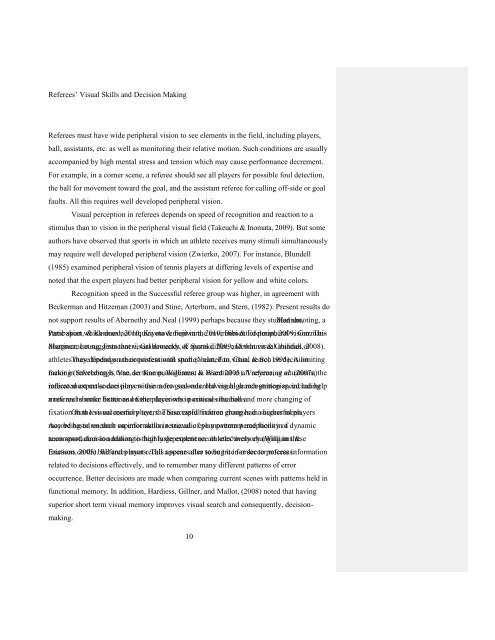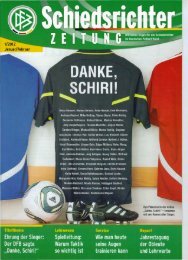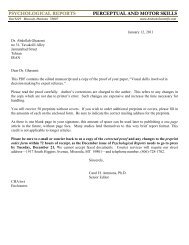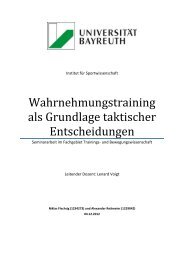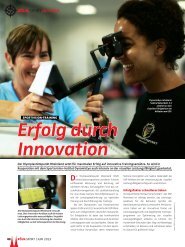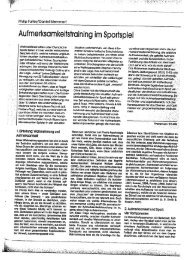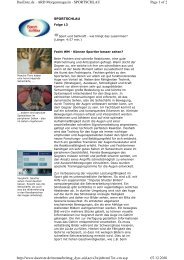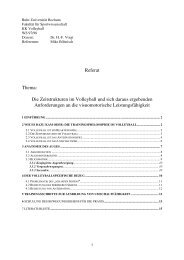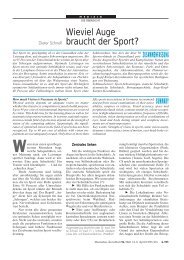psychological reports perceptual and motor skills - Dynamic-Eye
psychological reports perceptual and motor skills - Dynamic-Eye
psychological reports perceptual and motor skills - Dynamic-Eye
Create successful ePaper yourself
Turn your PDF publications into a flip-book with our unique Google optimized e-Paper software.
Referees’ Visual Skills <strong>and</strong> Decision Making<br />
Referees must have wide peripheral vision to see elements in the field, including players,<br />
ball, assistants, etc. as well as monitoring their relative motion. Such conditions are usually<br />
accompanied by high mental stress <strong>and</strong> tension which may cause performance decrement.<br />
For example, in a corner scene, a referee should see all players for possible foul detection,<br />
the ball for movement toward the goal, <strong>and</strong> the assistant referee for calling off-side or goal<br />
faults. All this requires well developed peripheral vision.<br />
Visual perception in referees depends on speed of recognition <strong>and</strong> reaction to a<br />
stimulus than to vision in the peripheral visual field (Takeuchi & Inomata, 2009). But some<br />
authors have observed that sports in which an athlete receives many stimuli simultaneously<br />
may require well developed peripheral vision (Zwierko, 2007). For instance, Blundell<br />
(1985) examined peripheral vision of tennis players at differing levels of expertise <strong>and</strong><br />
noted that the expert players had better peripheral vision for yellow <strong>and</strong> white colors.<br />
Recognition speed in the Successful referee group was higher, in agreement with<br />
Beckerman <strong>and</strong> Hitzeman (2003) <strong>and</strong> Stine, Arterburn, <strong>and</strong> Stern, (1982). Present results do<br />
not support results of Abernethy <strong>and</strong> Neal (1999) perhaps because they studied Mannan, shooting, a<br />
static Pambakian, sport which & Kennard, does not 2010; require Kiyota movement & Fujiwara, in the 2010; environment Bibi & Edelman, or peripheral 2009; vision. Guzman- This<br />
disagreement Martinez, Leung, suggests Franconeri, that visual Grabowecky, dem<strong>and</strong>s of & sports Suzuki, differ, 2009; <strong>and</strong> Dewhurst that visual & Crundall, abilities of 2008).<br />
athletes These may depend findings on are their consistent professional with sport studies (Yuan, related Fan, to visual Chin, search & So, 1995). on decision A limiting<br />
factor making in (Savelsbergh, refereeing is time, Van der so time Kamp, management Williams, & is essential Ward 2005). in all Vaeyens, refereeing et al. situations; (2007a) the<br />
referee indicated must expert make soccer decisions players within use more a few goal-oriented seconds. Having visual high search recognition strategies, speed including can help<br />
a more referee <strong>and</strong> to shorter make fixations better <strong>and</strong> on faster the player decisions who in possesses critical situations. the ball <strong>and</strong> more changing of<br />
fixation On than the less visual successful memory players. test, the These Successful rapid fixation referee group changes had in a successful higher mean. players<br />
According may be based to research on their superior on information <strong>skills</strong> in retrieval saccadic of eye play movement pattern perceptions <strong>and</strong> facility in of a dynamic<br />
team accommodation sport, decision in addition making to is their highly large dependent experience on athletes' in selectively memory changing (Williams in these &<br />
Ericsson, fixations on 2005). the ball Referees <strong>and</strong> players. must recall This a appears scene after also seeing to be true it in for order soccer to process referees. information<br />
related to decisions effectively, <strong>and</strong> to remember many different patterns of error<br />
occurrence. Better decisions are made when comparing current scenes with patterns held in<br />
functional memory. In addition, Hardiess, Gillner, <strong>and</strong> Mallot, (2008) noted that having<br />
superior short term visual memory improves visual search <strong>and</strong> consequently, decision-<br />
making.<br />
10


